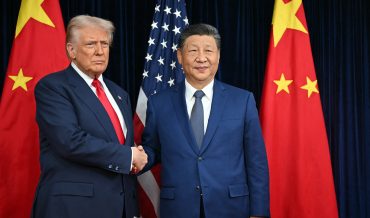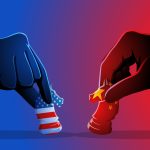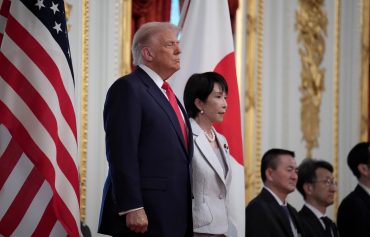
- Rare Earths
- Semiconductors
- Tariffs
- Trade Policy
Trump and Xi Strike Busan Trade Deal as U.S.–China Tensions Ease
10 minute read

Trump and Xi Jinping reach a one-year Busan trade accord easing tariffs and restoring rare-earth supplies as both economies face domestic strain.
Key Takeaways
- Limited Relief, Structural Tensions Intact: The accord reduces overall U.S. tariffs on Chinese goods from 57% to 47% and restores rare earth exports, but leaves fundamental disputes over subsidies, technology transfer, and market access unresolved.
- Mutual Vulnerability Drives Compromise: China’s economic contraction and U.S. dependence on rare earth minerals—100% import reliance for defense-critical materials—forced both leaders to negotiate despite deeper strategic rivalries.
- One-Year Framework Tests Durability: The agreement’s twelve-month term coincides with the 2026 midterm election cycle, creating political volatility while allowing both sides to claim tactical victories without surrendering core positions.
The Hangar Meeting
The handshake came without fanfare. In a closed hangar at Gimhae International Airport, away from the ceremonial pomp of the APEC summit unfolding nearby, Donald Trump and Xi Jinping ended six years of mutual avoidance with ninety minutes of direct negotiation. What emerged on October 30 was neither the comprehensive trade settlement both sides once envisioned nor the collapse many feared, but rather a narrowly constructed arrangement that addresses immediate pressure points while leaving fundamental disputes unresolved.
Trump described the encounter as “amazing,” rating it a “12 out of 10.” Xi, characteristically measured, acknowledged the American president’s “contributions to world peace.” Behind the diplomatic language lies a transaction born of necessity: the United States secures resumed access to rare earth minerals and modest tariff relief; China regains entry to American agricultural markets and breathing room for an economy under duress. The deal runs for one year.
Terms of Exchange
At its core, the Busan Accord recalibrates three specific trade imbalances. Washington will reduce tariffs on certain Chinese imports linked to fentanyl precursor enforcement from 20 percent to 10 percent, lowering the overall effective tariff rate on Chinese goods from 57 percent to 47 percent. Beijing, in exchange, commits to lifting its restrictions on rare earth exports—critical inputs for semiconductors, electric vehicles, and defense systems—and to substantially increasing purchases of American soybeans. The Chinese government also pledges enhanced enforcement against the production and export of fentanyl precursors.
These terms reflect immediate vulnerabilities on both sides. When Trump reassumed office in January, he moved swiftly to impose sweeping tariffs averaging 60 percent on roughly $500 billion in Chinese imports, citing unfulfilled commitments from the 2020 Phase One agreement, currency practices, and intellectual property concerns. China responded with targeted agricultural levies and, more consequentially, with export controls on rare earth elements—materials in which it commands 87 percent of global mining capacity and 92 percent of processing infrastructure.

Strategic Vulnerabilities Exposed
The economic impact proved severe. American manufacturers dependent on rare earth-derived magnets and alloys faced cost increases of 25 to 40 percent. Midwestern soybean producers, already battered by earlier trade conflicts, saw exports to China fall 35 percent year-over-year. Beijing’s July decision to halt rare earth shipments entirely, justified as a matter of “resource security,” exposed the extent of American dependence: the United States imports 100 percent of its rare earth needs, a strategic liability in sectors ranging from consumer electronics to national defense.
The national security dimensions sharpened the urgency. Neodymium enables the propulsion systems in F-35 fighter jets; dysprosium stabilizes guidance systems in precision munitions. The export suspension triggered emergency measures in Washington, including $2.8 billion in domestic mining incentives authorized under the Defense Production Act and accelerated stockpiling of critical materials. Trump’s subsequent threat to impose 100 percent tariffs across all Chinese imports unless cooperation resumed was credible enough to bring Xi to Busan.
Domestic Imperatives
For Xi, the calculation is equally stark. China’s economy, weighed down by a protracted property sector collapse and youth unemployment exceeding 17 percent, contracted 1.2 percent in the third quarter—its worst performance since 1976. Exports to the United States, still the largest single market despite decoupling rhetoric, dropped 12 percent under the tariff regime. The soybean concessions alone restore access to a $14 billion annual market, providing tangible relief to rural provinces like Heilongjiang and Jilin where agricultural discontent has mounted. Resuming rare earth flows, meanwhile, allows China to present itself as a stabilizing force in global supply chains ahead of the 2027 Party Congress, where Xi’s economic stewardship will face internal scrutiny.
Trump, for his part, leveraged geography and timing. South Korea, hosting APEC and freshly committed to its own package of concessions to Washington—including reduced automotive tariffs and $350 billion in investment pledges—provided neutral ground. The setting allowed Trump to extract visible wins without yielding on broader strategic concerns: there was no discussion of forced TikTok divestiture, no rollback of restrictions on Huawei, no softening on semiconductor export controls. The deal’s narrow scope is deliberate, preserving maximum flexibility.
Economic Impact Assessment
The economic implications warrant careful assessment. For American consumers and businesses, the tariff reduction on fentanyl-related chemicals offers limited but measurable relief, potentially trimming consumer price inflation by 0.2 to 0.4 percentage points in 2026. The resumption of rare earth supplies averts an estimated $50 billion disruption across technology and defense sectors, benefiting manufacturers from Tesla to Lockheed Martin. Agricultural producers stand to gain $5 billion to $7 billion in soybean revenue, according to USDA projections, lifting rural GDP growth toward 3.5 percent.
Yet structural tensions remain intact. Even at 47 percent, average tariffs on Chinese goods remain punitive by historical standards, well above pre-2018 levels and sufficient to sustain supply chain reorientation. The one-year duration ensures renegotiation will coincide with the approach of the 2026 midterm elections, introducing political volatility. Enforcement mechanisms rely on trust between governments that have repeatedly accused each other of bad faith; the U.S. Trade Representative has already signaled readiness to initiate Section 301 investigations at the first sign of non-compliance.
What Remains Unresolved
More fundamentally, the accord addresses symptoms rather than causes. It does nothing to resolve disputes over state subsidies, forced technology transfer, or market access in services. Taiwan, the South China Sea, and technology competition—the issues most likely to define U.S.-China relations over the next decade—received no mention in Busan. The deal buys time but settles nothing of lasting consequence.
Globally, the agreement signals managed competition rather than decoupling, at least in the near term. It provides space for Washington’s “friendshoring” strategy to mature: Australia’s Lynas Corporation is expanding rare earth production capacity by 50 percent through 2027, while Vietnamese mining operations are coming online. Beijing, in turn, gains room to test American resolve on security issues without the immediate threat of total economic rupture.
Regional Architecture Taking Shape
Trump’s separate agreements with South Korea and Japan during the APEC meetings suggest an emerging architecture: an Indo-Pacific economic arrangement organized around American security guarantees and market access, positioned as a counterweight to China’s Belt and Road infrastructure network. Whether this framework proves durable depends less on Busan’s specific terms than on whether both Washington and Beijing conclude that selective cooperation serves their interests better than confrontation.
History offers limited encouragement. A comprehensive review of the Phase One agreement revealed China met only 57 percent of its purchase commitments. The fentanyl crisis, despite previous assurances from Beijing, claimed over 110,000 American lives in 2024, with 90 percent of precursor chemicals traced to Chinese laboratories. Trump’s gift to Xi—a replica crown from Seoul’s agreement ceremony—captures the theatrical quality of the encounter: symbols matter, but delivery determines outcomes.
A Tactical Equilibrium
What Busan accomplishes, ultimately, is the establishment of a tactical equilibrium. Both leaders face domestic audiences that reward visible toughness while punishing economic pain. The arrangement allows each to claim success without surrendering core positions. For Trump, it demonstrates deal-making prowess while maintaining pressure through elevated tariffs. For Xi, it provides economic relief while preserving claims of sovereignty over trade policy and resource management.
The accord will endure as long as mutual vulnerability does. Should American rare earth alternatives mature faster than anticipated, or Chinese growth stabilize independent of U.S. agricultural imports, the incentives collapse. Should either leader face domestic political pressure requiring escalation, the framework dissolves. The next twelve months will test whether this balance can hold, or whether Busan represents merely an intermission in a longer confrontation.
Markets and policymakers will watch the implementation closely. The architecture of global trade increasingly depends not on rules-based multilateralism but on bilateral negotiations conducted under the shadow of strategic rivalry. Busan offers a template: narrow agreements on specific issues, time-limited commitments, enforcement through mutual leverage. It is pragmatic, transactional, and deeply contingent. Whether it constitutes progress depends on what one hoped to achieve. As a mechanism for avoiding immediate crisis, it succeeds. As a foundation for lasting stability, it remains unproven.







